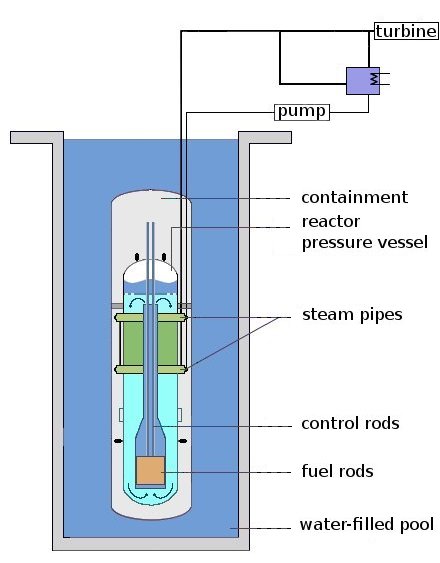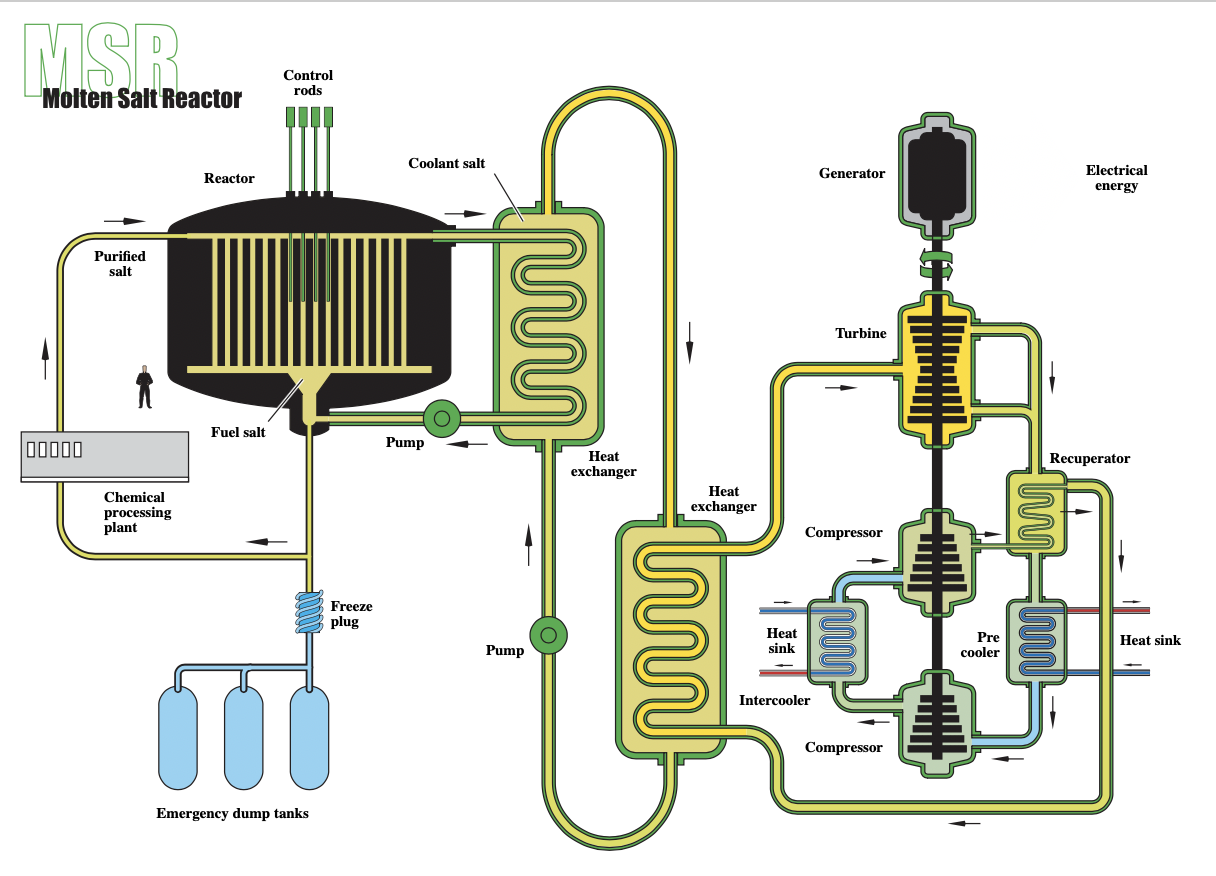Marc Grey
Due to concerns about human-induced climate change, many countries are embracing power grid configurations that feature ever-increasing components of wind and solar generation. Unfortunately, these sources have a highly non-optimal power generation curve:
- Peak output when demand is low
- Minimum output when demand is high
- Highly variable output
This means that increasing the generation capacity of these sources requires a corresponding increase in capacity of more continuously available ones as back up in order to avoid transient grid failures. Many countries use coal or natural gas generation to do this, resulting in increasing emissions – which just does not make sense!
On the face of it, nuclear power generation would be a better choice, but it is not being embraced in most Western countries (France is an exception here). While there are some technical challenges to using nuclear as a backup for wind and solar – sufficient responsiveness to grid load changes (which is solvable), this is not the reason for the lack of uptake of nuclear.
Since the Fukushima disaster, many countries’ media and politicians have painted nuclear power as too dangerous and instituted plans to discontinue its use. Ironically this is despite it still being statistically one of the safest sources of power, but these negative perceptions have become entrenched.
However, there are obvious downsides particular to nuclear power that make it an easy target for opponents to attack:
- Meltdown risk
- Waste storage
- Proliferation risk
Is it possible to mitigate these? In this article we are going to examine if we can and consider if new reactor designs and fuels could enable this.
Current Reactor Design
Before delving into how to fix the inherent shortcomings we will cover the design of a typical commercial reactor. Now there are a great many types of reactor designs, but most of the novel ones are military. A typical commercial power generating reactor is a ‘Light Water Reactor’ or LWR.

This can be thought of as a ‘nuclear steam engine’, as essentially it uses heat from controlled nuclear fission to generate steam which is used to turn a turbine (and generate electricity). Key elements of this type are:
- Solid fuel composed of 5% Uranium 235 (U235) and 95% U238 oxides
- Fuel encased in neutron transparent zirconium rods
- Rods placed together in a ‘Core’
- The core covered in water to cool/provide heat transfer
- Water also slows down (moderates) neutrons to provide sufficient fission probability
- The core is enclosed by a forged pressure vessel
- Control rods made of neutron absorbing material are used to control power level
- The entire system in enclosed in a reinforced concrete containment building
An overview of operation:
- Fuel (U235 only) undergoes fission, generates heat and emits neutrons which start a controlled chain reaction (fissioning more fuel)
- Water is heated/turned to steam and so takes heat from the core
- Steam either directly or indirectly (via heat exchanger) drives turbine coupled to an alternator to generate electricity
Examining problems with the design:
- Core is under very high pressure, leaks are explosive
- Power failure (grid disconnection) will stop water/steam circulating. Latent heat will build up, melt fuel rods and the hot zirconium will split Hydrogen from water and cause an explosion strong enough to destroy the pressure vessel (this happened at Fukushima)
- Solid fuel is incompletely consumed. Neutron impacts produce highly radioactive Transuranic elements e.g Plutonium 239 (Pu239). This toxic waste needs to be dealt with
- U235 is only 1% of naturally mined Uranium, so needs to be increased via an enrichment process to at least 5%. However, why stop there? It is easy to get to >90% which is weapons-grade.
Now, many of these problems can be worked around or solved. Note that the grid disconnection in particular is ridiculously easy to solve: even a ‘shutdown’ reactor has enough heat output to generate its own electricity! If this single modification had been installed at Fukushima, then the disaster would have been averted!
Re-Design
In the 1950s Alvin Weinberg (who incidentally invented the LWR) decided that LWR’s were not ideal for large commercial reactors (i.e. >= 1 GW), mainly due to meltdown risk. He proposed a new design and proceeded to build a prototype and run it for several years at Oak Ridge National Laboratory. Unfortunately, politics got involved and he was fired and the project shut down.
It was not until 2008 that Weinberg’s research was rediscovered by Kirk Sorensen and work was restarted to perfect a new design for commercial use. The design involves using a new fuel material – thorium, and dissolving it in molten salt to provide a liquid fuel not under pressure. This is usually referred to as a thorium ‘Molten Salt Reactor’ (MSR), and can be thought of as a ‘nuclear lava pit’! Key elements of this design are:
- Fuel Thorium (Th232), transmuted to Proactinium 233 (Pa233) and then U233 via neutron capture and decay (7 days)
- Dissolved in molten salt (e.g LiF-BeF, NaF etc)
- Optional separate coolant loop, also molten salt
- Core is an insulated, non pressurised container, with a drain tank immediately below
- Graphite neutron moderator around core
- Separate Th232 + salt ‘blanket’ to ‘breed’ more U233
- Run fuel (or coolant) salt through heat exchanger to spin steam turbine as usual, or CO2 turbine for better efficiency

The new fuel is not fissionable in its native state; only when it is transmuted into U233 does it become useful (it is a bit misleading to refer to these as ‘Thorium MSRs’ since the fuel is in fact uranium…but the terminology has stuck).
An overview of operation:
- Fuel (U233 ) undergoes fission, generates heat and emits neutrons which start a controlled chain reaction (fissioning more fuel)
- Salt is heated and takes heat from the core
- Coolant (or fuel) salt exchanges heat with CO2 to drive turbine and make electricity
Consider how this design solves the problems mentioned in the LWR section:
- Technically cannot melt down as is liquid, but loss of power or coolant will cause overheating. This will open an actively cooled freeze plug into the drain tank; fuel flows to there – reaction stops (no moderator) and fuel slowly cools. Can be reheated and put back into core after the event cleared
- Not operating under pressure, leaks not explosive
- High operational temperature (approx 600 degrees) compared to LWR (200 degrees), better thermal efficiency
- Natural Thorium is 99.96% Th232, no enrichment required
- Liquid fuel can be completely consumed, resulting in vastly less waste and typical storage time of 300 years. Waste from LWR can be used in this design to re-process it, reducing the storage time required from from 100,000 years to 300 years!
- U233 is suitable for weapons but is contaminated with traces of U232, which emits gamma rays and so is not suitable for a weapon. However, if Pa233 is extracted from reactor fuel salt, it can make 100% U233.
In addition, the use of liquid fuel makes for other non power related possibilities:
- Extraction of exotic fission products useful for medicine (alpha emitters for cancer treatment)
- Easy access to high temps (600 degrees) allows for economically desalinating sea water
- Easy access to high temps means economically splitting water to get Hydrogen for non CO2 emitting truck and jet engines.
- Easy access to high temps means economically recycling materials (plastic, steel)
- Can use LWR toxic waste as augmented fuel
So sounds too good to be true, what are the challenges?
- High temperature operation needs special construction materials (Hastelloy N, graphite)
- Pumps and monitors need to work with molten salt
- Scaling up 10 MW Oak Ridge design to 100-200 MW
- Need neutron emitter for initial Th232 to U233 transmutation (this can be any of U233 – from another such reactor, U235/238, Pu239 – from LWR waste, or even custom particle accelerator)
- It is possible to make weapons grade U233
Analysis
This new design clearly solves two of the drawbacks that most concern folk (meltdown risk and waste materials). This should make the nuclear power option much less frightening. In addition the remarkable new options mean it might even be possible to ‘re-image’ the nuclear industry from a marketing perspective. One massive elephant in the room is the Green lobby – can they get over their nuclear hatred?
We are left with the issue of proliferation risk. That is a tough one! In some ways proliferation is not really a reactor based issue. Any sufficiently developed economy can construct an enrichment process for U235 or an irradiation + extraction process for U233 without building any reactors (e.g. Iran has highly enriched U235, but no reactors yet). Proliferation looks likely to get worse – with or without new reactor designs.
Commercialisation
Is anyone looking at building these? The rediscovery of thorium as a possible fuel and the use of molten salt have re-spawned interest in new reactor designs. So there are projects looking at using Thorium as a fuel – but not necessarily in a MSR – and there are others looking at types of MSR using U235 as a fuel.
As far as thorium MSR projects go, some examples are Kirk Sorensen’s Flibe Energy in the USA, and Thorcon [14] based in Indonesia, looking at a seabed based hybrid U235/U233. China is actively pursuing development.
In the case of the USA – it is unknown if the newly installed Biden administration will ignore or actively hamper the regulation process for thorium and MSR designs.
Please share this BFD article so others can discover The BFD.






